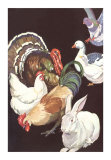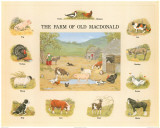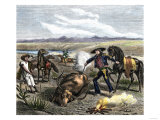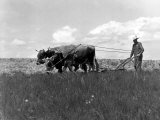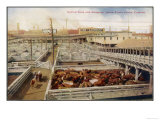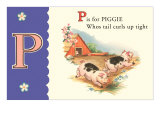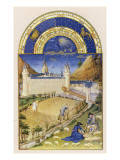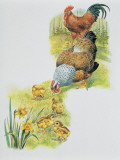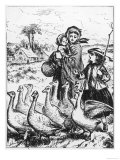|
|
Farm Animals Educational Posters, Prints & Charts
for the classroom; theme decor for home and office.
|
social studies > animals > FARM ANIMALS < mammals < zoology < biology < science
|
|
Farming is the production of food and materials through growing plants and animals.
Domesticated animals in farming are referred to as livestock and include horses, mules, donkeys, cattle, pigs, goats, sheep, rabbits, chickens, ducks, and geese.
The terms agriculture, agronomy, horticulture, and animal husbandry describe the activities of farming and raising plants and animals.
|
|
Old MacDonald Had a Farm is a children's song about the variety of animals kept on a farm.
Each verse names an animal and the sound the animal makes, for example:
Old MacDonald had a farm, E-I-E-I-O.
And on that farm he had a cow, E-I-E-I-O.
With a moo-moo here, and a moo-moo there,
Here a moo, there a moo, everywhere a moo-moo,
Old MacDonald had a farm, E-I-E-I-O.
|
|
|
|
|
|
|
Cattle, of the genus Bos, have been domesticated since Neolithic period (10,000 BC) in the Middle East. Different species or breeds are raised for meat (beef), dairy products (butter and cheeses); they also provide hides (leather) and are used as draft animals for pulling plows and wagons.
Male cattle are known as bulls, females as cows, young cattle are calves. Males that have been castrated are known as steers, a female that has not had a calf is called a heifer.
Cattle are naturally grazing animals eating grasses that their 4 chambers stomachs can digest. This allowed early cattle domesticators to use land that was not suitable for crops; recently cattle have been force fed corn in feed lots to increase the growth rate, thus the supply of beef to the market place - see King Corn video.
Cattle are part of the human story through mythology and religion. The curved horns of the bull represented the cresent moon in Mesopotania and the Epic of Gilgamesh; the Minotaur was the half man, half bull of Greek mythology, and Greek art shows the sport of bull-leaping; Mithra was the deity of Zoroastrianism who slays the Sacred Bull – it seems the Roman soldiers who worshipped Mithras took the ritual bull killing to the Iberian Peninsula; Hinduism holds cattle as sacred; the Golden Calf of the Moses Bible story. Taurus is the Zodiac's Bull; Paul Bunyan was a folklore lumberjack with his Blue Ox, Babe.
The word cattle is related to the Latin “caput” for head and meant “moveable property” and “capital” as in economics.
FYI - I just unraveled the mystery of why my father, a farmer, would call the cows by hollering “Here Bossy, Bossy, Bossy.” When I questioned him, he just said that was what he learned as a child.
|
|
|
|
Pigs, also called hogs and swine, are ungulates (hoofed), omnivores (eat both plants and animals), in the genus Sus within the Suidae family. Pigs are native to Eurasia and have been domesticated for millenia, across many cultures, as sources of meat (pork), leather, and bristles for brushes. Today pigs are also used in biomedical research. The species nearest to the swine family are the North American peccaries.
A male pig is called a boar, the female pig is called a sow, the babies are piglets. Today swineherds, the old name for someone who tends foraging pigs, is more likely called a pig farmer, and the pigs are kept in a confined space.
“Being a pig” is associated with gluttony and being dirty, however pigs are also very intelligent. Pigs, which do not have sweat glands, have learned that laying in soft, cool mud on a hot day is nicer than laying on hard ground – also have skin sensitive to sunburn (mud has a high SPF), and prefer that biting flies have to bite into mud first.
Examples of pigs in culture is the fairy tale “Three Little Pigs”, the classic “Charlotte's Web” the movie “Babe”, and “Piglet” in Winnie the Pooh stories. The prodigal son, in the parable from the New Testament, ended up working as a swineherd, indicating the depths to which the prideful young man had to sink before he was humbled enough to return home.
• “Watch out when you're getting all you want. Fattening hogs ain't in luck.” Joel Chandler Harris
|
|
|
|
Sheep are one of the earliest animals to be domesticated, probably in Mesopatamia as much as eleven thousand years ago. Sheep are “quadrupedal (four footed), even-toed ungulates (cloven hooves) ruminant (digesting food in two steps) mammals”, kept as livestock for their wool fleece and meat (lamb and mutton).
A male sheep is called a ram, a female is a ewe, and the baby sheep is called a lamb. A group of sheep are a flock and the person responsible for taking care of the sheep is a shepherd or shepherdess, many times with very intelligent dogs to help guide flocks and protect wandering sheep from predators.
Sheep's wool is usually harvested by shearing and is a vitally important fiber for clothing and shelter.
Sheep have been a part of human culture for millenia. One story is the Greek myth of Jason and the Golden Fleece. In the Hebrew Bible God provides Abraham with a sacrificial ram in place of his son; in Christianity, Jesus is seen as a shepherd to lost sheep.
In the Zodiac, Aries is the Ram, related to “headstrong”, could cause one to think of a battering ram; and then there are the nursery rhymes “Baa, Baa, Black Sheep” and “Little Bo-Peep” that use sheep to say something else.
|
|
|
|
Chickens
• “Do not count your chickens before they are hatched.” Aesop
|
|
|
|
|
previous page | top
|
|
I have searched the web for visual, text, and manipulative curriculum support materials - teaching posters, art prints, maps, charts, calendars, books and educational toys featuring famous people, places and events - to help teachers optimize their valuable time and budget.
Browsing the subject areas at NetPosterWorks.com is a learning experience where educators can plan context rich environments while comparing prices, special discounts, framing options and shipping from educational resources.
Thank you for starting your search for inspirational, motivational, and educational posters and learning materials at NetPosterWorks.com. If you need help please contact us.
|
|
|

















